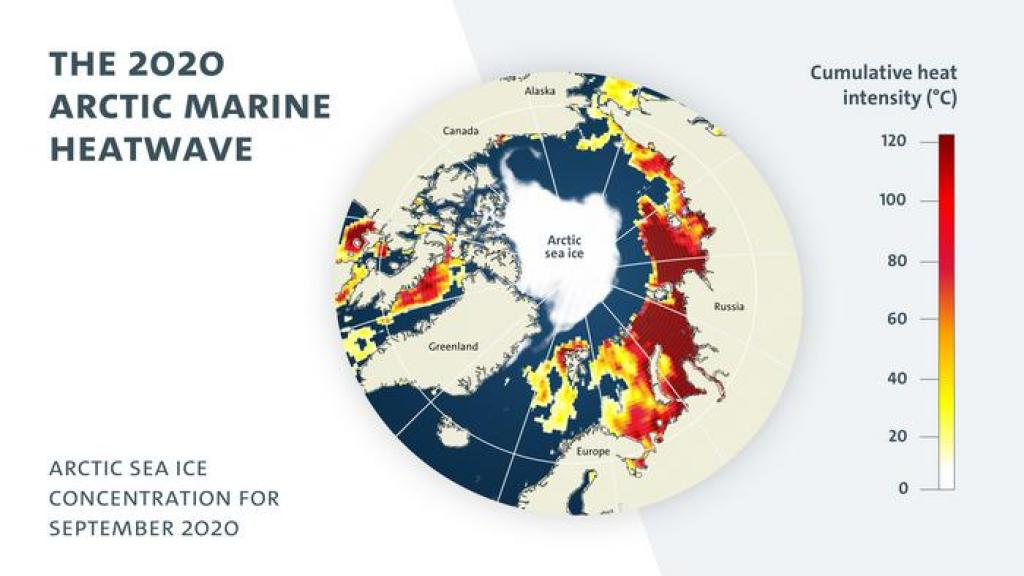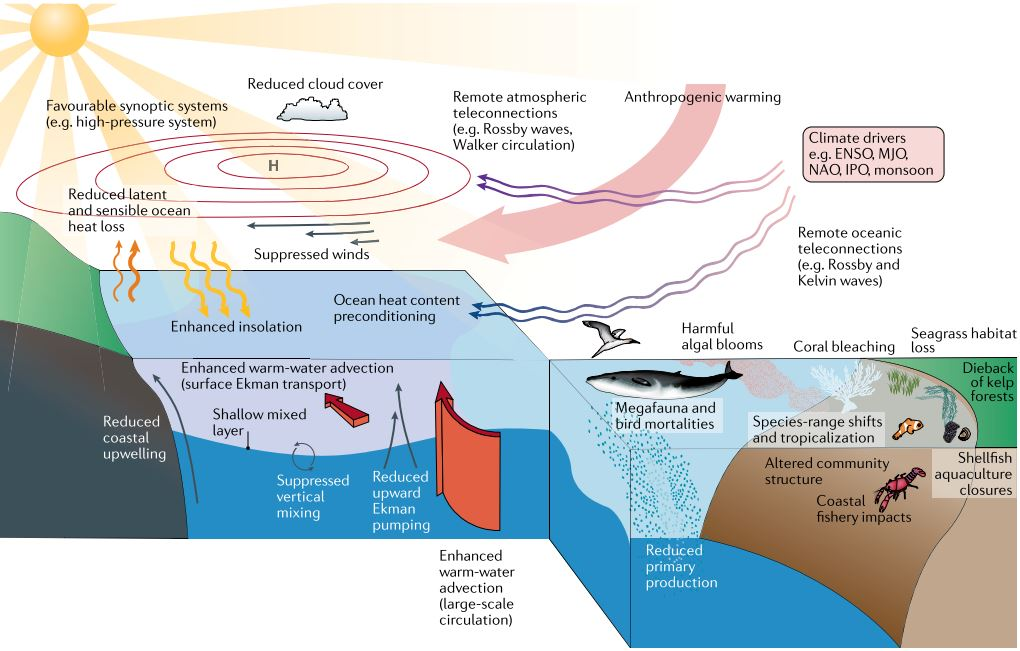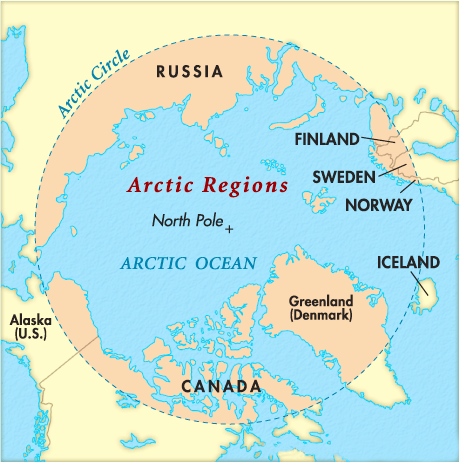Biodiversity & Environment
Marine Heatwaves in Arctic Ocean
- 16 Feb 2024
- 12 min read
For Prelims: Greenhouse Gas (GHG), Arctic Ocean, Marine Heatwave, Food Chains.
For Mains: Marine Heatwaves in Arctic Ocean, Environmental pollution and degradation.
Why in News?
Recently, a new study has been published in the journal Nature Communications titled- ‘Arctic marine heatwaves forced by greenhouse gases and triggered by abrupt sea-ice melt’, which shows that since 2007, unprecedented Marine Heatwave (MHW) events have occurred over the Arctic Ocean.
What are the Key Highlights of the Study?
- Arctic Marine Heatwaves (MHWs) Characteristics:
- There have been 11 MHW events in the Arctic from 2007 to 2021, characterized by prolonged high Sea Surface Temperatures (SST).
- These events coincide with record declines in Arctic Sea ice.
- In 2022, the Arctic saw severe and extreme marine heatwaves in the Laptev and Beaufort seas from spring to autumn, according to the State of the Global Climate 2022 report.
- Decrease in Ice Cover:
- The perennial sea ice cover over the Arctic Ocean, known to reflect solar radiation, has seen a marked decrease in both summer and winter since the mid-1990s.
- Since 2007, there has been a pronounced regime shift from a thicker and deformed ice cover to a thinner and more uniform one.
- The thin ice is less durable and melts more quickly, allowing incoming solar radiation to warm the water’s surface.
- Drivers of Arctic MHWs:
- Arctic MHWs primarily occur over marginal seas, including the Kara, Laptev, East Siberian, and Chukchi seas.
- These regions are characterized by shallow mixed-layer depths and predominantly first-year ice cover, creating conditions conducive to MHW development.
- First-year ice refers to sea ice that forms and grows during a single winter season and typically melts away completely during the following summer melt season.
- Abrupt sea ice retreat is another concern as it could trigger marine heatwave events.
- Impact of GreenHouse Gas (GHG):
- Without GHGs, marine heatwaves exceeding 1.5°C couldn't happen.
- GHGs are a sufficient cause for moderate marine heatwaves, with a 66-99% probability.
- Without GHGs, marine heatwaves exceeding 1.5°C couldn't happen.
- Long-Term Trends:
- There is a pronounced long-term warming trend in the Arctic, with SST increasing at a rate of 1.2°C per decade from 1996 to 2021.
- Over the last two decades, there has been an increase in the frequency of extreme SST events in the eastern Arctic marginal seas.
- Concerns:
- The study warned of dramatic consequences of Marine heatwaves like impact on food chains, fish stocks and reduction of overall biodiversity.
- Technique Used in the Study:
- The study employs an Extreme Event Attribution (EEA) technique to assess the role of Greenhouse Gas (GHG) forcing in Arctic MHWs.
- The EEA technique determines the extent to which human-induced climate change influences the likelihood and severity of specific extreme weather events.
What are Marine Heat Waves (MHWs)?
- About:
- An MHW is an extreme weather event. It occurs when the surface temperature of a particular region of the sea rises to 3 or 4 degree Celsius above the average temperature for at least five days.
- According to the National Oceanic and Atmospheric Administration (NOAA), MHWs can last for weeks, months or even years.
- Impacts:
- Impact on Ocean: An increase of 3 or 4 degrees Celsius in average temperatures can be catastrophic for marine life.
- MHWs along the Western Australian coast in 2010 and 2011 caused some “devastating” fish kills, the sudden and unexpected death of many fish or other aquatic animals over a short period and mainly within a particular area.
- MHWs destroyed kelp forests and fundamentally altered the ecosystem of the coast.
- Kelps usually grow in cooler waters, providing habitat and food for many marine animals.
- Leading to Coral Bleach: In 2005 high ocean temperatures in the tropical Atlantic and Caribbean led to a massive coral bleaching event.
- Corals are very sensitive to the temperature of the water in which they live. When water gets too warm, they expel the algae known as zooxanthellae, living in their tissues, causing them to turn entirely white. This is called coral bleaching.
- Impact on Humans: Higher ocean temperatures, which are associated with MHWs, can make storms like hurricanes and tropical cyclones stronger.
- With warmer temperatures, the rate of evaporation escalates and so does the transfer of heat from the oceans to the air. When storms travel across hot oceans, they gather more water vapour and heat.
- This results in more powerful winds, heavier rainfall and more flooding when storms reach the land — meaning heightened devastation for humans.
- Impact on Ocean: An increase of 3 or 4 degrees Celsius in average temperatures can be catastrophic for marine life.
What are the other Impacts of Marine Heatwaves?
- Affect the Structure of Ecosystem:
- Marine heatwaves influence the composition of ecosystems by favouring certain species while inhibiting others.
- They have been linked to widespread mortality among marine invertebrates and can compel species to alter their behaviour, potentially exposing wildlife to greater risks of harm.
- Change Habitat Ranges:
- Marine heatwaves can change the habitat ranges of certain species, such as the spiny sea urchin off southeastern Australia which has been expanding southward into Tasmania at the expense of kelp forests which it feeds upon.
- Economic Losses:
- Marine heatwaves can cause economic losses through impacts on fisheries and aquaculture.
- Affect Biodiversity:
- Biodiversity can be drastically affected by marine heatwaves.
- The previous marine heatwave led to the bleaching of 85% of corals in the Gulf of Mannar near the Tamil Nadu coast.
- Biodiversity can be drastically affected by marine heatwaves.
- Increase the Risk of Deoxygenation and Acidification:
- Often, they occur alongside other stressors such as ocean acidification, deoxygenation, and overfishing.
- In such cases, MHWs not only further damage habitats but also increase the risk of deoxygenation and acidification.
What are the Key Facts About the Arctic?
- About:
- The Arctic is a polar region located in the northernmost part of Earth.
- The Arctic consists of the Arctic Ocean, adjacent seas, and parts of Alaska (United States), Canada, Finland, Greenland (Denmark), Iceland, Norway, Russia, and Sweden.
- The Arctic Ocean consists of the Barents Sea, Kara Sea, Laptev Sea, Chukchi Sea, Beaufort Sea, Wandel Sea, Lincoln Sea.
- Land within the Arctic region has seasonally varying snow and ice cover.
- Ecological Impact of Warming on the Arctic:
- The loss of ice and the warming waters will affect sea levels, salinity levels, current movement and precipitation patterns.
- The Tundra is returning to the swamp, the permafrost is thawing, sudden storms are ravaging coastlines and wildfires are devastating interior Canada and Russia.
- Tundra: A type of vegetation, found in regions north of the Arctic Circle and south of the Antarctic Circle. These are treeless regions.
- The Arctic is also home to about 40 different indigenous groups like Chukchi in Russia, Aleut, Yupik and Inuit in Alaska.
UPSC Civil Services Examination, Previous Year Questions (PYQs)
Prelims
Q.1 On 21st June, the Sun (2019)
(a) does not set below the horizon at the Arctic Circle
(b) does not set below the horizon at Antarctic Circle
(c) shines vertically overhead at noon on the Equator
(d) shines vertically overhead at the Tropic of Capricorn
Ans: (a)
Q.2 Which of the following statements is/are correct about the deposits of ‘methane hydrate’? (2019)
- Global warming might trigger the release of methane gas from these deposits.
- Large deposits of ‘methane hydrate’ are found in Arctic Tundra and under the sea floor.
- Methane in atmosphere oxidizes to carbon dioxide after a decade or two.
Select the correct answer using the code given below.
(a) 1 and 2 only
(b) 2 and 3 only
(c) 1 and 3 only
(d) 1, 2 and 3
Ans: (d)
Exp:
- Methane hydrate is a crystalline solid that consists of a methane molecule surrounded by a cage of interlocking water molecules. It is an “ice” that only occurs naturally in subsurface deposits where temperature and pressure conditions are favourable for its formation.
- Regions with suitable temperature and pressure conditions for the formation and stability of methane hydrate– sediment and sedimentary rock units below the Arctic permafrost; sedimentary deposits along continental margins; deep-water sediments of inland lakes and seas; and, under Antarctic ice. Hence, statement 2 is correct.
- Methane hydrates, the sensitive sediments, can rapidly dissociate with an increase in temperature or a decrease in pressure. The dissociation produces free methane and water, which can be triggered by global warming. Hence, statement 1 is correct.
- Methane is removed from the atmosphere in about 9 to 12-year period by oxidation reaction where it is converted into Carbon Dioxide. Hence, statement 3 is correct.
- Therefore, option (d) is the correct answer.
Mains
Q1. Assess the impact of global warming on the coral life system with examples. (2017)
Q2. ‘Climate change’ is a global problem. How India will be affected by climate change? How Himalayan and coastal states of India will be affected by climate change? (2017)
Q3. Discuss global warming and mention its effects on the global climate. Explain the control measures to bring down the level of greenhouse gases which cause global warming, in the light of the Kyoto Protocol, 1997. (2022)









